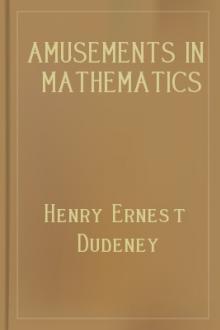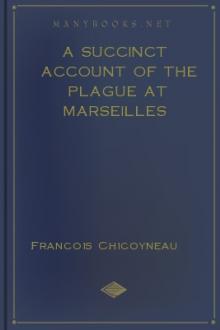Amusements in Mathematics, Henry Ernest Dudeney [books to read to be successful txt] 📗

- Author: Henry Ernest Dudeney
- Performer: 0486204731
Book online «Amusements in Mathematics, Henry Ernest Dudeney [books to read to be successful txt] 📗». Author Henry Ernest Dudeney
390.—THE HORSE-RACE PUZZLE.—solution
The answer is: £12 on Acorn, £15 on Bluebottle, £20 on Capsule.
391.—THE MOTOR-CAR RACE.—solution
The first point is to appreciate the fact that, in a race round a circular track, there are the same number of cars behind one as there are before. All the others are both behind and before. There were thirteen cars in the race, including Gogglesmith's car. Then one-third of twelve added to three-quarters of twelve will give us thirteen—the correct answer.
392.—THE PEBBLE GAME.—solution
In the case of fifteen pebbles, the first player wins if he first takes two. Then when he holds an odd number and leaves 1, 8, or 9 he wins, and when he holds an even number and leaves 4, 5, or 12 he also wins. He can always do one or other of these things until the end of the game, and so defeat his opponent. In the case of thirteen pebbles the first player must lose if his opponent plays correctly. In fact, the only numbers with which the first player ought to lose are 5 and multiples of 8 added to 5, such as 13, 21, 29, etc.
393.—THE TWO ROOKS.—solution
The second player can always win, but to ensure his doing so he must always place his rook, at the start and on every subsequent move, on the same diagonal as his opponent's rook. He can then force his opponent into a corner and win. Supposing the diagram to represent the positions of the rooks at the start, then, if Black played first, White might have placed his rook at A and won next move. Any square on that diagonal from A to H will win, but the best play is always to restrict the moves of the opposing rook as much as possible. If White played first, then Black should have placed his rook at B (F would not be so good, as it gives White more scope); then if White goes to C, Black moves to D; White to E, Black to F; White to G, Black to C; White to H, Black to I; and Black must win next move. If at any time Black had failed to move on to the same diagonal as White, then White could take Black's diagonal and win.

394.—PUSS IN THE CORNER.—solution
No matter whether he plays first or second, the player A, who starts the game at 55, must win. Assuming that B adopts the very best lines of play in order to prolong as much as possible his existence, A, if he has first move, can always on his 12th move capture B; and if he has the second move, A can always on his 14th move make the capture. His point is always to get diagonally in line with his opponent, and by going to 33, if he has first move, he prevents B getting diagonally in line with himself. Here are two good games. The number in front of the hyphen is always A's move; that after the hyphen is B's:—
33-8, 32-15, 31-22, 30-21, 29-14, 22-7, 15-6, 14-2, 7-3, 6-4, 11-, and A must capture on his next (12th) move, -13, 54-20, 53-27, 52-34, 51-41, 50-34, 42-27, 35-20, 28-13, 21-6, 14-2, 7-3, 6-4, 11-, and A must capture on his next (14th) move.
395.—A WAR PUZZLE GAME.—solution
The Britisher can always catch the enemy, no matter how clever and elusive that astute individual may be; but curious though it may seem, the British general can only do so after he has paid a somewhat mysterious visit to the particular town marked "1" in the map, going in by 3 and leaving by 2, or entering by 2 and leaving by 3. The three towns that are shaded and have no numbers do not really come into the question, as some may suppose, for the simple reason that the Britisher never needs to enter any one of them, while the enemy cannot be forced to go into them, and would be clearly ill-advised to do so voluntarily. We may therefore leave these out of consideration altogether. No matter what the enemy may do, the Britisher should make the following first nine moves: He should visit towns 24, 20, 19, 15, 11, 7, 3, 1, 2. If the enemy takes it into his head also to go to town 1, it will be found that he will have to beat a precipitate retreat the same way that he went in, or the Britisher will infallibly catch him in towns 2 or 3, as the case may be. So the enemy will be wise to avoid that north-west corner of the map altogether.

Now, when the British general has made the nine moves that I have given, the enemy will be, after his own ninth move, in one of the towns marked 5, 8, 11, 13, 14, 16, 19, 21, 24, or 27. Of course, if he imprudently goes to 3 or 6 at this point he will be caught at once. Wherever he may happen to be, the Britisher "goes for him," and has no longer any difficulty in catching him in eight more moves at most (seventeen in all) in one of the following ways. The Britisher will get to 8 when the enemy is at 5, and win next move; or he will get to 19 when the enemy is at 22, and win next move; or he will get to 24 when the enemy is at 27, and so win next move. It will be found that he can be forced into one or other of these fatal positions.
In short, the strategy really amounts to this: the Britisher plays the first nine moves that I have given, and although the enemy does his very best to escape, our general goes after his antagonist and always driving him away from that north-west corner ultimately closes in with him, and wins. As I have said, the Britisher never need make more than seventeen moves in all, and may win in fewer moves if the enemy plays badly. But after playing those first nine moves it does not matter even if the Britisher makes a few bad ones. He may lose time, but cannot lose his advantage so long as he now keeps the enemy from town 1, and must eventually catch him.
This is a complete explanation of the puzzle. It may seem a little complex in print, but in practice the winning play will now be quite easy to the reader. Make those nine moves, and there ought to be no difficulty whatever in finding the concluding line of play. Indeed, it might almost be said that then it is difficult for the British general not to catch the enemy. It is a question of what in chess we call the "opposition," and the visit by the Britisher to town 1 "gives him the jump" on the enemy, as the man in the street would say.
Here is an illustrative example in which the enemy avoids capture as long as it is possible for him to do so. The Britisher's moves are above the line and the enemy's below it. Play them alternately.
The enemy must now go to 25 or B, in either of which towns he is immediately captured.
396.—A MATCH MYSTERY.—solution
If you form the three heaps (and are therefore the second to draw), any one of the following thirteen groupings will give you a win if you play correctly: 15, 14, 1; 15, 13, 2; 15, 12, 3; 15, 11, 4; 15, 10, 5; 15, 9, 6; 15, 8, 7; 14, 13, 3; 14, 11, 5; 14, 9, 7; 13, 11, 6; 13, 10, 7; 12, 11, 7.
The beautiful general solution of this problem is as follows. Express the number in every heap in powers of 2, avoiding repetitions and remembering that 20 = 1. Then if you so leave the matches to your opponent that there is an even number of every power, you can win. And if at the start you leave the powers even, you can always continue to do so throughout the game. Take, as example, the last grouping given above—12, 11, 7. Expressed in powers of 2 we have—
As there are thus two of every power, you must win. Say your opponent takes 7 from the 12 heap. He then leaves—
Here the powers are not all even in number, but by taking 9 from the 11 heap you immediately restore your winning position, thus—
And so on to the end. This solution is quite general, and applies to any number of matches and any number of heaps. A correspondent informs me that this puzzle game was first propounded by Mr. W.M.F. Mellor, but when or where it was published I have not been able to ascertain.
397.—THE MONTENEGRIN DICE GAME.—solution
The players should select the pairs 5 and 9, and 13 and 15, if the chances of winning are to be quite equal. There are 216 different ways in which the three dice may fall. They may add up 5 in 6 different ways and 9 in 25 different ways, making 31 chances out of 216 for the player who selects these numbers. Also the dice may add up 13 in 21 different ways, and 15 in 10 different ways, thus giving the other player also 31 chances in 216.
398.—THE CIGAR PUZZLE.—solution
Not a single member of the club mastered this puzzle, and yet I shall show that it is so simple that the merest child can understand its solution—when it is pointed out to him! The large majority of my friends expressed their entire bewilderment. Many considered that "the theoretical result, in any case, is determined by the relationship between the table and the cigars;" others, regarding it as a problem in the theory of Probabilities, arrived at the conclusion that the chances are slightly in favour of the first or second player, as the case may be. One man took a table and a cigar of particular dimensions, divided the table into equal sections, and proceeded to make the two players fill up these sections so that the second player should win. But why should the first player be so accommodating? At any stage he has only to throw down a cigar obliquely across several of these sections entirely to upset Mr. 2's calculations! We have to assume that each player plays the best possible; not that one accommodates the other.
The theories of some other friends would be quite sound if the shape of the cigar were that of a torpedo—perfectly symmetrical and pointed at both ends.
I will show that the





Comments (0)